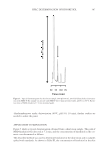HPLC DETERMINATION OF HINOKITIOL 383 integrator (Shimadzu). The mobile phase was prepared by the addition of acetonitrile (500 ml) to 500 ml of Milli-Q water containing trifl uoroacetic acid (0.1 v/v%). The samples were eluted from the column at room temperature at a fl ow rate of 0.40 ml/min. REAGENTS Hinokitiol, NBD-F, and seven parabens (methyl 4-hydroxybenzoate, ethyl 4-hydroxybenzoate, propyl 4-hydroxybenzoate, isopropyl 4-hydroxybenzoate, butyl 4-hydroxybenzoate, isobutyl 4-hydroxybenzoate, and benzyl 4-hydroxybenzoate) were obtained from Tokyo Chemical Industry Co., Ltd. (Tokyo, Japan). General reagents were obtained from Wako Pure Chemical Industries (Osaka, Japan). Skin lotion was purchased from a market in Kanazawa city, Ishikawa Prefecture, Japan. PROCEDURES Preparation of standard solutions. A stock solution of hinokitiol (40 μg/ml) in 1% ethanol was prepared in a dark glass bottle and stored at 4°C. It was diluted appropriately with water to prepare several working solutions. The working concentration of hinokitiol was set at 0, 0.2, 0.4, 0.7, 1, 2, and 4 μg/ml. Derivatization. Ultrapure water was from a Milli-Q water purifi cation system (Simplicity® UV, Millipore Corporation, Bedford, MA). Borate buffer (0.1 M) was adjusted to pH 9.0 by the addition of NaOH. Borate buffer (50 μl) was added to each working standard solution (50 μl) then NBD-F solution in acetonitrile (2 mg/ml, 50 μl) was added. The mixture was vortexed and allowed to react for 10 min at 60°C then an aliquot (20 μl) was injected into the HPLC system. Sample preparation and addition-recovery tests. Tested skin lotion contains hinokitiol, para- ben, allantoin, perfume, and so on. Concentration of the composition was not expressed. An aliquot of skin lotion (500 μl) was diluted to 100 ml with water, and analyzed after derivatization as described earlier. Addition-recovery tests were carried out to assess the accuracy of the method by spiking skin lotion (500 μl) with hinokitiol (50 or 100 μg) and diluting it in the same manner. An aliquot of 50 μl was analyzed, and the hinokitiol concentration in the sample was determined. Recovery was calculated as follows: 100 Total amount after spiking – Spiked amount Recovery (%) Original amount = × RESULTS AND DISCUSSION DERIVATIZATION OF HINOKITIOL WITH NBD-F For the time course study, the reaction time was set at 5, 7.5, 10, 15, 20, or 30 min at 60°C. Hinokitiol (50 μl, 2 μg/ml), borate buffer (50 μl, pH 9.0), and NBD-F (50 μl, 2 mg/ml) were mixed as described in the Experimental section. The derivatization of hinokitiol reached a plateau at 10 min (Fig. 2).
JOURNAL OF COSMETIC SCIENCE 384 Next, the pH dependency (pH 7.5–10.0) was examined at the derivatization time of 10 min at 60°C. The peak area of NBD-hinokitiol was maximal at pH 9.0 (Fig. 3). Thus, the derivatization time of 10 min at pH 9.0 was selected. CHROMATOGRAMS Fig. 4 shows typical chromatograms obtained from blank (A) and standard sample (B, 1 μg/ml). The retention time of NBD-hinokitiol was 7.2 min. The running time was 15 min. Figure 2. Time course of the formation of the NBD derivative of hinokitiol. The standard sample (2 μg/ml) was reacted with NBD-F in borate buffer, pH 9.0, at 60°C. Figure 3. pH dependency of the formation of the NBD derivative of hinokitiol. The standard sample (2 μg/ml) was reacted with NBD-F for 10 min at 60°C in borate buffer at various pH values.
Purchased for the exclusive use of nofirst nolast (unknown) From: SCC Media Library & Resource Center (library.scconline.org)





















































































